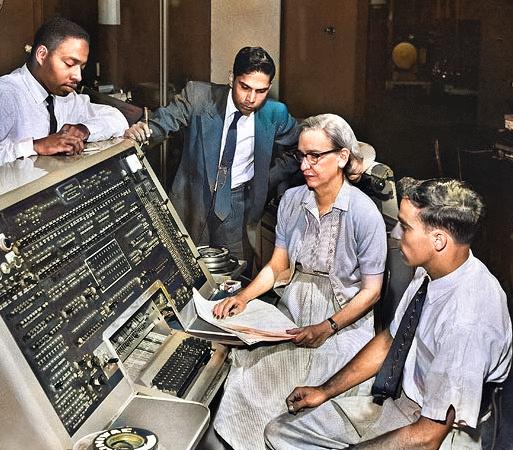
Grace Hopper at the UNIVAC keyboard, c. 1960
On December 9, 1908, American computer scientist Grace Brewster Murray Hopper was born. Besides being credited for having invented the term “debugging”, Hopper was one of the first programmers of the Harvard Mark I computer in 1944. She invented the first compiler for a computer programming language and was one of those who popularized the idea of machine-independent programming languages which led to the development of COBOL, one of the first high-level programming languages. We already reported on Grace Hopper as the one who found the first “computer bug“. But, there are much more and esp. more important achievements to report about for Grace Hopper.
“We must include in any language with which we hope to describe complex data-processing situations the capability for describing data. We must also include a mechanism for determining the priorities to be applied to the data. These priorities are not fixed and are indicated in many cases by the data. “
– Grace Hopper
Early Years
Grace Brewster Murray was born in New York City, the oldest in a family of three children, to Walter Fletcher Murray and Mary Campbell Van Horne. Grace was curious as a child, a lifelong trait: at the age of seven she decided to determine how an alarm clock worked, and dismantled seven alarm clocks before her mother realized what she was doing (she was then limited to one clock). Rejected for early admission to Vassar College at age 16 because her test scores in Latin were too low, she was admitted the following year and graduated in 1928 with a bachelor’s degree in mathematics and physics. She joined the Vassar faculty in 1931, and continued her studies in mathematics at Yale University, where she earned an MA in 1930 and a PhD in 1934 with a dissertation on “New Types of Irreducibility Criteria“. She was one of four women in a doctoral program of ten students, and her doctorate in mathematics was a rare accomplishment in its day. In 1941, she was promoted to associate professor.
Working with Howard Aiken
She was married to New York University professor Vincent Foster Hopper (1906–76) from 1930 until their divorce in 1945. Although she never remarried, and she kept his surname. he remained at Vassar as an associate professor until 1943, when she joined the United States Naval Reserve. She had to get an exemption to enlist; she was about 7 kg below the Navy minimum weight of 54 kg. After her basic training, she was assigned to the Bureau of Ordnance Computation Project at Harvard University, where she worked at Harvard’s Cruft Laboratories on the Mark I computer programming staff headed by Howard H. Aiken.[10] Hopper and Aiken coauthored three papers on the Mark I. Hopper’s request to transfer to the regular Navy at the end of the war was declined due to her age (38). Hopper remained at the Harvard Computation Lab until 1949, turning down a full professorship at Vassar in favor of working as a research fellow under a Navy contract at Harvard.
A True Visionary
A true visionary, Grace Hopper conceptualized how a much wider audience could use the computer if there were tools that were both programmer-friendly and application-friendly. In pursuit of her vision she risked her career in 1949 to join the Eckert-Mauchly Computer Corporation and provide businesses with computers. There she began yet another pioneering effort of UNIVAC I, the first large-scale electronic digital computer. To ease their task, Admiral Hopper encouraged programmers to collect and share common portions of programs. Even though these early shared libraries of code had to be copied by hand, they reduced errors, tedium, and duplication of effort.[2]
Compiler Based Programming Languages
In the early 1950s, the company was taken over by the Remington Rand corporation, and it was while she was working for them that her original compiler work was done. The compiler was known as the A compiler and its first version was A-0. The A-O series of compilers translated symbolic mathematical code into machine code, and allowed the specification of call numbers assigned to the collected programming routines stored on magnetic tape. One could then simply specify the call numbers of the desired routines and the computer would find them on the tape, copy them to the main storage and execute the instructions. In 1952 the compiler went operational and in 1954 Hopper was named the company’s first director of automatic programming, and her department released some of the first compiler-based programming languages, including MATH-MATIC and FLOW-MATIC.
COBOL
In 1959, CODASYL or the Conference on Data Systems Languages brought together different computer experts for a 2-day conference. Hopper had been the committee’s technical consultant, and she along with her previous employees helped define COBOL (COmmon Business-Oriented Language). The new language extended Hopper’s FLOW-MATIC language with some ideas from the IBM equivalent, COMTRAN. Hopper’s belief that programs should be written in a language that was close to English (rather than in machine code or in languages close to machine code, such as assembly languages) was captured in the new business language, and COBOL went on to be the most ubiquitous business language to date.
Computer Networks
In the 1970s, Hopper advocated for the Defense Department to replace large, centralized systems with networks of small, distributed computers. Any user on any computer node could access common databases located on the network. She developed the implementation of standards for testing computer systems and components, most significantly for early programming languages such as FORTRAN and COBOL.
Awards and Achievements
In her long career Hopper received so many awards that it would be impossible to note more than a few at this place. She was elected a Fellow of the Institute of Electrical and Electronics Engineers (1962), a Fellow of the American Association for the Advancement of Science (1963), and received Achievement Awards from the Society of Women Engineers (1964) and from the Institute of Electrical and Electronics Engineers (1968). Hopper was named the first computer science Man of the Year by the Data Processing Management Association in 1969. She became the first woman to be elected Distinguished Fellow of the British Computer Society in 1973. Moreover, Hopper collected a remarkable number of honorary degrees, receiving at least 37 between 1972 and 1987. In 1991 President George Bush awarded Hopper the National Medal of Technology. On New Year’s Day 1992, Grace Hopper died in her sleep of natural causes at her home in Arlington, Virginia, at age 85.
Grace Hopper, lecture* on the future of computing, MIT Lincoln Lab, [9]
References and Further Reading:
- [1] The Bug that wasn’t really a Bug – Computer Pioneer Grace Murray Hopper, yovisto blog, September 9, 2012.
- [2] Grace Murray Hopper at Yale.edu
- [3] Grace Hopper at the Mathematics Genealogy Project
- [4] Norwood, Arlisha. “Grace Hopper”. National Women’s History Museum. 2017.
- [5] O’Connor, John J.; Robertson, Edmund F., “Grace Hopper“, MacTutor History of Mathematics archive, University of St Andrews.
- [6] “Cyber Heroes of the past: “Amazing Grace” Hopper”.
- [7] Grace Hopper at Wikidata
- [8] Billings, Charlene (1989). Grace Hopper : Navy admiral and computer pioneer. Enslow Publishers
- [9] Grace Hopper, lecture* on the future of computing, MIT Lincoln Lab, 1985, MIT Lincoln Laboratory @ youtube
- [10] Howard Aiken and the Harvard Mark I Computer, SciHi Blog
- [11] “Grace Murray Hopper (1906–1992): A legacy of innovation and service”. YaleNews.
- [12] Castellanos-Monfil, Román (December 9, 2015). “Happy 109th birthday to Yale alumna Grace Hopper, a pioneer in computer science”. YaleNews.
- [13] Lee, J.A.N. “Computer Pioneers — Grace Brewster Murray Hopper”. IEEE Computer Society and the Institute of Electrical and Electronics Engineers.
- [14] Norman, Rebecca (June 1997). “Biographies of Women Mathematicians: Grace Murray Hopper”. Agnes Scott College.
- [15] Timeline of Women Computer Scientists, via DBpedia and Wikidata






Pingback: Whewell’s Gazette: Year 2, Vol. #22 | Whewell's Ghost
Pingback: Whewell’s Gazette: Year 3, Vol. #17 | Whewell's Ghost